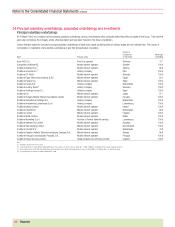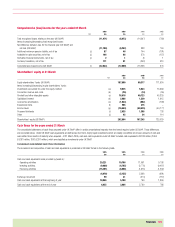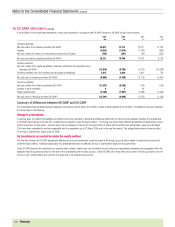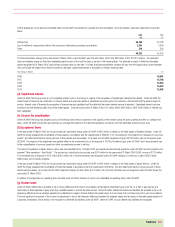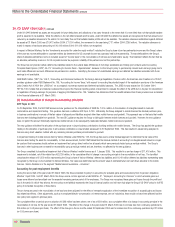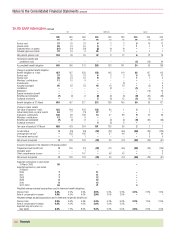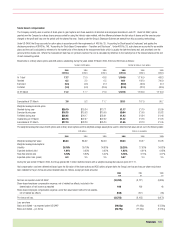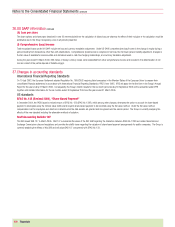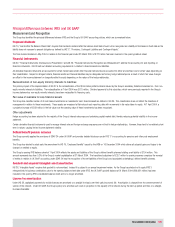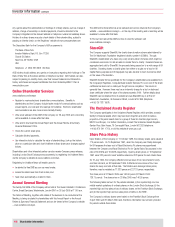Vodafone 2005 Annual Report Download - page 134
Download and view the complete annual report
Please find page 134 of the 2005 Vodafone annual report below. You can navigate through the pages in the report by either clicking on the pages listed below, or by using the keyword search tool below to find specific information within the annual report.
Notes to the Consolidated Financial Statements continued
132 |Financials
36.US GAAP information continued
Under UK GAAP, deferred tax assets are recognised for future deductions and utilisations of tax carry-forwards to the extent that it is more likely than not that suitable taxable
profit is expected to be available. While the effects on the net deferred assets are the same, under US GAAP, the deferred tax assets are recognised at their full amounts and
reduced by a valuation allowance to the extent it is more likely than not that suitable taxable profits will not be available. The valuation allowance established against deferred
tax assets at 31 March 2005 was £10,413 million (2004: £11,150 million), the movement in the year being £737 million (2004: £296 million). The valuation allowance is
mainly in respect of tax losses amounting to £10,413 million (2004: £11,018 million) not recognised.
In respect of Verizon Wireless, the line “Investments accounted for under the equity method”includes the Group’s share of pre-tax partnership income and the Group’s share
of the post-tax income attributable to corporate entities (as determined for US corporate income tax purposes) held by the partnership. The tax attributable to the Group’s
share of allocable partnership income is included as part of “Income taxes”in the reconciliations of net loss and shareholders’ equity. This treatment reflects the fact that tax
on allocable partnership income is, for US corporate income tax purposes, a liability of the partners and not the partnership.
The Group has not provided certain deferred tax liabilities related to the outside basis differences of its foreign subsidiaries and foreign joint ventures under Accounting
Principles Board Opinion (“APB”) No. 23, “Accounting for Income Taxes – Special Areas”, because it is the Group’s policy to permanently reinvest such earnings giving rise to
such basis differences and such differences are permanent in duration. Quantifying the amount of undistributed earnings and deferred tax liabilities associated with those
earnings is not practicable.
FASB Staff Position (“FSP”) No. 109-2, “Accounting and Disclosure Guidance for the Foreign Earnings Repatriation Provision within the American Jobs Creation Act of 2004”,
provides guidance under FASB Statement No. 109, “Accounting for Income Taxes,”with respect to recording the potential impact of the repatriation provisions of the American
Jobs Creation Act of 2004 (the “JOBS Act”) on a company’s income tax expense and deferred tax liability balances. The JOBS Act was enacted on 22 October 2004.
FSP No. 109-2 states that an enterprise is allowed time beyond the financial reporting period of enactment to evaluate the effect of the JOBS Act on its plan for reinvestment
or repatriation of foreign earnings for purposes of applying FAS Statement No. 109. Vodafone has determined that the benefits obtained from these provisions are immaterial
to the financial statements at 31 March 2005.
(h) Cumulative effect of changes in accounting principles
EITF Topic D-108
On 29 September 2004, the SEC Staff announced new guidance on the interpretation of SFAS No. 142 in relation to the valuation of intangibles assets in business
combinations and impairment testing. This guidance has been codified as EITF Topic D-108. Historically, the Group assigned to mobile licences the residual purchase price
in business combinations in excess of the fair values of all assets and liabilities acquired other than mobile licences and goodwill. This approach was on the basis that mobile
licences were indistinguishable from goodwill. The new SEC guidance requires the Group to distinguish between mobile licences and goodwill. However, the new guidance
does not permit the amount historically reported as mobile licences to be subsequently reallocated between mobile licences and goodwill.
The new guidance will affect the allocation of the purchase price in future business combinations involving entities with mobile licences. The Group has applied the guidance
relating to the allocation of purchase price to all business combinations consummated subsequent to 29 September 2004. This has resulted in values being assigned to
licences using direct valuation method with any remaining residual purchase price allocated to goodwill.
In impairment testing of mobile licences held by Verizon Wireless under SFAS No. 142, the Group has used a similar residual approach to determine the fair value of the
licences when testing the asset for recoverability. In their announcement, the SEC Staff stated that the residual method of accounting for intangible assets should no longer
be used and that companies should perform an impairment test using a direct method on all assets which were previously tested using a residual method. The Group’s
licences in other business are not tested for recoverability using a residual method and are, therefore, not affected by the new guidance.
The Group completed its transitional impairment test of Verizon Wireless’ mobile licences as of 1 January 2005. This resulted in a pre-tax charge of £11,416 million. This
impairment is included, net of the related tax of £5,239 million, in the cumulative effect of change in accounting principle in the reconciliation of net loss. The tax effect
comprises the release of £1,220 million representing the Group’s share of Verizon Wireless’ deferred tax liabilities and £4,019 million deferred tax liabilities representing taxes
recognised by the Group on its investment in Verizon Wireless. Fair value was determined as the present value of estimated future net cash flows allocable to the mobile
licences. Verizon Wireless is in the segment “Mobile telecommunications – Americas”.
Accounting for post employment benefits
During the second half of the year ended 31 March 2005, the Group amended its policy for accounting for actuarial gains and losses arising from its pension obligations
effective 1 April 2004. Until 31 March 2004, the Group used a corridor approach under SFAS No. 87, “Employers’ Accounting for Pensions”in which actuarial gains and
losses were deferred and amortised over the expected remaining service period of the employees. The Group now recognises these gains and losses through the profit and
loss in the period in which they arise as the new policy more faithfully represents the Group’s financial position and will more fully align the Group’s US GAAP policy to its IFRS
policy of immediate recognition of these items.
The pro forma amounts in the reconciliation of net loss have been adjusted for the effect of retroactive application of the immediate recognition of actuarial gains and losses
less related tax effects. Other adjustments, such as to employee/director compensation or interest expense, are not included as these would not have been affected had the
new policy been applied in previous years.
The cumulative effect on periods prior to adoption of £288 million has been shown, net of tax of £93 million, as a cumulative effect of a change in accounting principle in the
reconciliation of net loss for the year ended 31 March 2005. The effect of the change in the year ended 31 March 2005 was to increase loss from continuing operations by
£55 million (or 0.08 pence per share). The effect of the change on the six months ended 30 September 2004 was to increase loss from continuing operations by £31 million
(or 0.05 pence per share).


